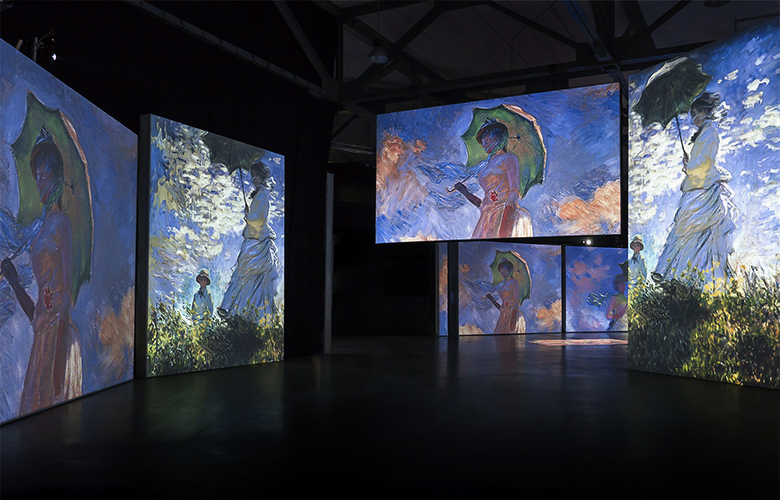
A digitised theme park of art: enjoyed by some, questioned by others.
Sydney, March 12 to April 6
Australian Bruce Petersen is developing an empire of super-experiences. He’s done it with sharks, Alice in Wonderland, Van Gogh, Di Vinci, Monet and is on his way to developing a science-based exhibition.
What’s the connection between sharks and Monet? His company, Grande Experiences, uses advanced digital technology to display images on huge screens in large spaces. The images in the shark show were created by an international team of shark experts and marine biologists. The oceanographic cinematography created an entertaining shark experience that toured the world.
Then Grande Experiences turned its attention to famous artists. The Van Gogh show, projecting digitised images of the famous paintings on huge screens, was presented in fifty cities around the world in indoor venues and one outdoor space in Wellington, New Zealand.
We’ve been habituated to appreciating art by wandering in galleries and stopping in front of a painting to contemplate its meaning, its technique, its story. This is the complete opposite. But it is another way of finding a painting’s meaning, technique and story.
I found myself asking “What would Monet think of all this?” Would he have approved of the digitised altered images of his work? Would he think his life’s work had been reduced to mere entertainment? Would he think the integrity of his work was lessened?
Anyone can appropriate an image as long as the artist has been dead for 70 years. You can put a moustache on the Mona Lisa. You can set Shakespeare’s Hamlet in the Amazon, you can add a bowtie to Michelangelo’s David. And you can digitise and magnify Monet.
I went along to the show expecting to be disappointed. But I was delighted to watch the mesmerised crowd attending the opening. Many liked the extravaganza. Mostly I enjoyed watching other people’s pleasure, especially the children’s fascination with the light and music.
Monet’s obsession with painting nature, particularly the French countryside, led him to adopt an inventive painting style of impressionism that is basis of the Monet and Friends exhibition now in Sydney.
You enter a large space with panels of information about the sixteen artists presented. Prominently featured are Monet, Renoir, Degas, Pissarro, Cezanne, Toulouse-Lautrec and Sisley. There are two women artists featured: Berthe Morisot and Mary Cassatt. It is well worth lingering in this first room. (You won’t be able to return to it once you enter the next much larger hall.) Easy-to-read displays describe the artists and their place in the development of impressionism. There is also a smattering of information about the science of colour and of synaesthesia, the phenomenon whereby one sensory pathway stimulates another sensory pathway leading to heightened sensual response.
There is also a life-size reconstruction of Monet’s famous painting, ‘Bridge Over Water Lilly Pond’. People queue (line up) to walk over the metre wide and about seven meter long bridge with artificial flowers hanging from he ceiling. One-by-one people walk to the middle of the bridge where friends on the other side can take a photo of them in the painting. This has the effect of turning Monet’s work into a theme park. But, again, most people enjoyed standing inside famous painting.
Then you enter the large hall where the real show is. Here, aromas of flowers and herbs, and 19th century music are piped into a cavern-like area with fifty huge screens. Images of the paintings, the artists, the settings of the paintings and quotations from the artists flash up on the screens around you and beneath you. For example, a painting of ballet dancers in white tutus by Degas is on a wall screen. Images of real ballerinas dancing in white tutus is projected on the floor screen beneath the painting. A street scene by Pissarro has a photograph of the actual street on the next screen. Quotes by the artists are also flashed up on the screens such as this one attributed to Monet: ‘Colour is my day-long obsession, joy and torment’.
I stood where I found a strong scent of jasmine. I listened to the music of Debussy, Saint-Saens, Grieg, Ravel and Mascagni while watching the paintings and photographs flash all around me. I found myself enjoying the experience.
The Sensory4 technology augmented every shot on the screens. Monet’s famous brush stroke technique is highly illuminated. Everything is more intense, brighter and bigger than the originals. Having seen most of the original paintings, I felt happy that people who haven’t been fortunate enough to see these wonderful paintings can go Monet and Friends and get a good idea of the artists’ intent. Everyone will understand that it’s not the real thing and enjoy it for what it is. Children will delight in the super-scale show. Adults who adore French impressionism will delight in this ‘celebritia’ of these 19th century celebrities.
The show runs a for about 50 minutes. That’s about the right time. Otherwise it might all start to look like wall paper.
Then you exit through the giftshop (thanks, Banksy) where you can buy books, bags, posters, a T-shirts with a print of the Monet’s ponds on the front.
Tickets are $50. The merchandise is standard art gallery gift shop prices. Then you exit out to the street where the real colours are.
DriveINSIDE Manchester: The World’s First Covid Compliant Theatre
West End Musical Drive-In Shows For Spring 2021


Carol is a Sydney playwright, producer and artist. She has had four full-length plays and 14 short plays produced (Sydney, Malaysia, India). Her published plays are at australianplays.org. Reviews of her latest play are at www.kissofthegalleryguard.net.au/reviews. Her artwork is at www.paintingsbycaroldance.com
Read Full Profile© 2021 TheatreArtLife. All rights reserved.

Thank you so much for reading, but you have now reached your free article limit for this month.
Our contributors are currently writing more articles for you to enjoy.
To keep reading, all you have to do is become a subscriber and then you can read unlimited articles anytime.
Your investment will help us continue to ignite connections across the globe in live entertainment and build this community for industry professionals.